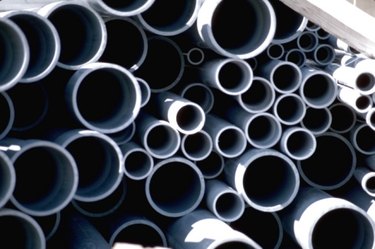
PVC pipe manufacturers print arcane inscriptions across the various colors and sizes of pipe. If you become familiar with the language of the building materials industry, you can more easily decipher the meaning of the mysterious messages and determine the applications and capabilities of each pipe. Understanding the differences between the types of PVC plumbing pipes prepares you to choose the right type of pipe for any job.
Wall Thickness
Video of the Day
Builders and engineers classify PVC pipes according to wall thickness. Building industry professionals refer to wall thickness as "schedule" and assign each schedule a number. The most common schedules applied to commercial and residential plumbing are schedule 40 and schedule 80. The wall of a schedule 40 pipe is thinner than the wall of a schedule 80 pipe. For each respective schedule, wall thickness increases as the pipe's diameter increases. For example, a 1/2-inch diameter schedule 40 pipe has a thinner wall than a 1-inch diameter schedule 40 pipe. The thicker schedule 80 pipe is more resistant to crushing and puncture than schedule 40 pipe. Also, schedule 80 PVC resists greater pressure than schedule 40 PVC. Most manufacturers produce schedule 40 in an off-white color and schedule 80 in gray.
Video of the Day
Diameter
A PVC pipe's diameter limits the volume of water that can flow through the pipe, a characteristic referred to as "flow rate." Landscapers and builders measure a pipe's flow rate in gallons per minute. Small diameter pipes carry less gallons per minute than large diameter pipes. Although the concept sounds simple, other factors affect diameter choice during the construction of PVC water supply systems. For example, low water pressure restricts the builder to smaller diameter pipes.
Chlorinated PVC
Usually green in color, chlorinated PVC (CPVC) handles hotter water than standard PVC. Whereas standard PVC generally handles water up to 140 degrees Fahrenheit, CPVC carries water up to 180 degrees Fahrenheit. CPVC commonly appears in recreational vehicles, such as motor homes and travel trailers as well as manufactured mobile homes. Acceptability of CPVC for single-family residential plumbing varies according to municipality.